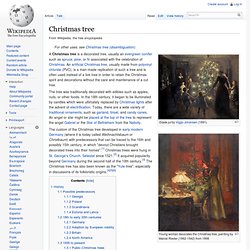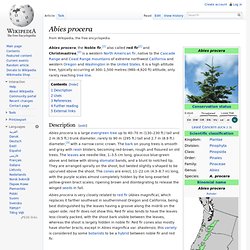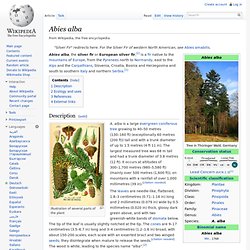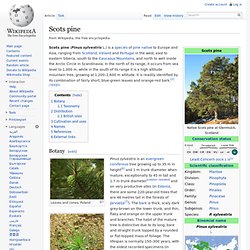

Christmas tree. Young woman decorates the Christmas tree, painting by Marcel Rieder (1862-1942) from 1898 A Christmas tree is a decorated tree, usually an evergreen conifer such as spruce, pine, or fir associated with the celebration of Christmas.

An artificial Christmas tree, usually made from polyvinyl chloride (PVC), is a man-made replication of such a tree and is often used instead of a live tree in order to retain the Christmas spirit and decorations without the care and maintenance of a cut tree. The tree was traditionally decorated with edibles such as apples, nuts, or other foods.
In the 18th century, it began to be illuminated by candles which were ultimately replaced by Christmas lights after the advent of electrification. Picea omorika. Description[edit] Serbian Spruce in its native range.

Note extremely slender shape of crown. Noble Fir. Description[edit] Abies procera is a large evergreen tree up to 40–70 m (130–230 ft.) tall and 2 m (6.5 ft.) trunk diameter, rarely to 90 m (295 ft.) tall and 2.7 m (8.9 ft.) diameter,[3] with a narrow conic crown.

The bark on young trees is smooth and gray with resin blisters, becoming red-brown, rough and fissured on old trees. The leaves are needle-like, 1–3.5 cm long, glaucous blue-green above and below with strong stomatal bands, and a blunt to notched tip. They are arranged spirally on the shoot, but twisted slightly s-shaped to be upcurved above the shoot. The cones are erect, 11–22 cm (4.3–8.7 in) long, with the purple scales almost completely hidden by the long exserted yellow-green bract scales; ripening brown and disintegrating to release the winged seeds in fall. Uses[edit] Noble fir is a popular Christmas tree. The wood is used for general structural purposes and paper manufacture. References[edit] Further reading[edit] Conifer Specialist Group (1998).
External links[edit] Abies nordmanniana. It is a large evergreen coniferous tree growing to 60 m tall and with a trunk diameter of up to 2 m.

In the Western Caucasus Reserve, some specimens have been reported to be 78 m and even 85 m tall,[3] the tallest trees in Europe. The leaves are needle-like, flattened, 1.8–3.5 cm long and 2 mm wide by 0.5 mm thick, glossy dark green above, and with two blue-white bands of stomata below. The tip of the leaf is usually blunt, often slightly notched at the tip, but can be pointed, particularly on strong-growing shoots on young trees. The cones are 10–20 cm long and 4-5 cm broad, with about 150–200 scales, each scale with an exserted bract and two winged seeds; they disintegrate when mature to release the seeds. There are two subspecies (treated as distinct species by some botanists), intergrading where they meet in northern Turkey at about 36°E longitude: The species is named after Finnish zoologist Alexander von Nordmann (1803–1866), Professor of Botany at Odessa. Uses[edit] References[edit] Abies alba. "Silver Fir" redirects here.

For the Silver Fir of western North American, see Abies amabilis. Abies alba, the silver fir or European silver fir,[2] is a fir native to the mountains of Europe, from the Pyrenees north to Normandy, east to the Alps and the Carpathians, Slovenia, Croatia, Bosnia and Herzegovina and south to southern Italy and northern Serbia.[1] Description[edit] Illustration of several parts of the plant A. alba is a large evergreen coniferous tree growing to 40–50 metres (130–160 ft) (exceptionally 60 metres (200 ft)) tall and with a trunk diameter of up to 1.5 metres (4 ft 11 in). The leaves are needle-like, flattened, 1.8–3 centimetres (0.71–1.18 in) long and 2 millimetres (0.079 in) wide by 0.5 millimetres (0.020 in) thick, glossy dark green above, and with two greenish-white bands of stomata below.
Picea abies. Norway spruce (Picea abies) is a species of spruce native to Europe.

It is also commonly referred to as the European spruce. Description[edit] Norway spruce shoot. Cross-section of a Norway spruce needle Young conifers of Norway spruce (Chornohora, Ukrainian Carpathians) A pineapple gall 'pseudocone' caused by Adelges abietis on a Norway spruce. Dissected pineapple 'pseudocone' galls. It is a large, fast-growing evergreen coniferous tree growing 35–55 m (115–180 ft) tall and with a trunk diameter of 1 to 1.5 m. Scots Pine. Scots pine (Pinus sylvestris L.) is a species of pine native to Europe and Asia, ranging from Scotland, Ireland and Portugal in the west, east to eastern Siberia, south to the Caucasus Mountains, and north to well inside the Arctic Circle in Scandinavia.

In the north of its range, it occurs from sea level to 1,000 m, while in the south of its range it is a high altitude mountain tree, growing at 1,200–2,600 m altitude. It is readily identified by its combination of fairly short, blue-green leaves and orange-red bark.[2][3][4][5] Botany[edit] Gardens - Rhizotron & Xstrata Treetop Walkway - Pinus sylvestris.
The national tree of Scotland and a native of much of Europe, the Scots pine is synonymous with its timber.

Centuries of deforestation have decimated the tree's population, but it is still abundant thanks to continued planting. Found as far south as Spain, as far north as Lapland and as far east as Siberia, is the only pine native to Britain. As its common name suggests, it is resident in Scotland especially in the Highlands where it is suited to the tough, unremitting conditions. The Scots pine seems to have a permanently windswept look wherever it lives, with its uneven and twisted branches and patchy foliage. As a youth, it has a typically conical coniferous shape, with evenly spaced branches. The timber of has played an important part in industry since the 17th century.
Scots pine. The Scots pine belongs to the genus Pinus and is a member of the Pine family (Pinaceae).

Scots pine (Pinus sylvestris) is a conifer tree growing to over 35m and flowering May to June. Lifespan: in the UK some of the oldest trees are over 500 years old and in Europe some are over 700 years of age. Bark is scaly grey-brown with a distinctive orange-red colouration; with age, the bark becomes more plated and fissured. Buds are small, pointed and reddish-brown. Scots Pine Pinus sylvestris. The Scots Pine is our only native conifer to be grown commercially for timber.

This tree has a large, long, conical trunk which spreads into a broad domed crown (maybe better indicating on the picture). The heavy and short branches grow outwards from the trunk. The shape is very distinct where the growth is slower; usually at higher altitudes or on poorer soils. The Scots Pine can then take on a squashed and weather beaten look. The Woodland Trust. Species profile: Scots pine. (Pinus sylvestris) As the largest and longest-lived tree in the Caledonian Forest, the Scots pine is a keystone species (see Principles of Ecological restoration) in the ecosystem, forming the 'backbone' on which many other species depend. Distribution Scots pine is the most widely distributed conifer in the world, with a natural range that stretches from beyond the Arctic Circle in Scandinavia to southern Spain and from western Scotland to the Okhotsk Sea in eastern Siberia.
Within this range it grows at elevations from sea level to 2,400 metres (8,000 feet), with the elevation generally increasing from north to south. Despite this wide distribution, the Scots pine forests in Scotland are unique and distinct from those elsewhere because of the absence of any other native conifers. Distribution in Scotland.